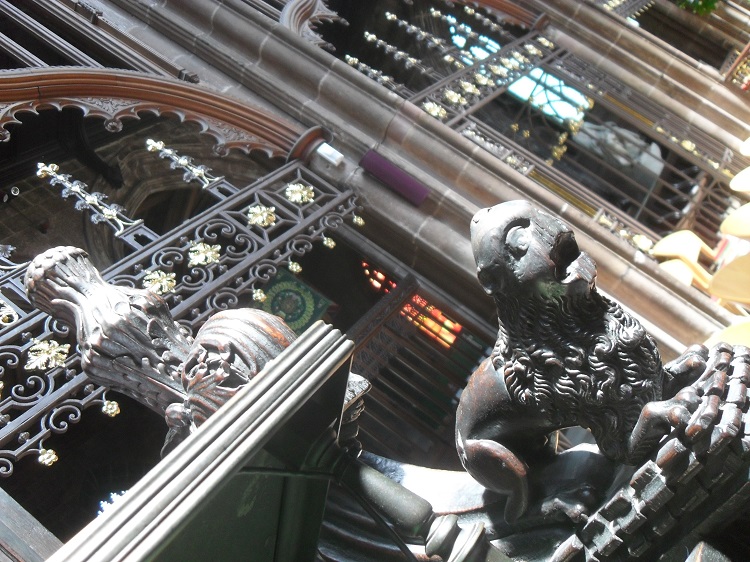
Sherry Ashworth was the Manchester born Jewish author who had the privilege of conducting a conversation with Booker Prize winning Manchester Jewish author Howard Jacobson at the Royal Exchange last night. Part of the Manchester International Festival this informal event was held in partnership with the Manchester Jewish Museum, and coincided with the play based on his book “The Mighty Waltzer” about his adolescence. A book which mentions shyness, Jewishness and table- tennis more times than any other I have read.
The Hanging Bridge, which spanned Hanging Ditch, is now completely built-over and little of it survives. The natural brook that it spanned is no longer here either. However it is one of few extant pieces of Medieval Manchester, and as such must be preserved.
The Society Of Friends, or Quakers as they are probably better known, have a large and airy Meeting House (church) in the centre of the city opposite the Central Library.
It was the first time I have ventured inside the building and to be honest I really didn't know what to expect. What I found surprised me - not the architecture, the people. I was greeted by a smiling and helpful member of staff, and made to feel very welcome and at home - not because I was a reviewer, that was a courtesy afforded to everyone - and was in no way rushed. It was a very relaxed, easy atmosphere and a place I could spend as much time in as I pleased with absolutely no pressure.
And before I get to the exhibition itself, there was also a table laid out for all visitors to the exhibits to help themselves to coffee, tea, water, fairy cakes and fresh fruit. An extremely pleasant and in this day and age frankly quite amazing surprise, but most welcome.
In a small and uninspiring basement room in the Royal Northern College of Music in Manchester lies a collection of 375 historical instruments from around the world. The room is somewhat cramped and negotiating the display cases (some as old as the items they display) is not easy. However, do persevere, as what the collection has to offer is rare and remarkable.
The collection is an amalgam of three smaller collections; two of which were private collections bequeathed to the college by their respective owners, Henry Watson and Josiah Chapman. The last part came in 1976 when the city of Manchester added its collection to them.
Since the brochure to accompany this exhibition puts it far better than I ever could, I quote; ' (this exhibition) examines the performative and melodramatic connotations associated with racial politics in an evolving post-digital 21st century. Oral histories and verbatim storytelling drawn from theatre and cinema, painting and sculpture, confront the fluid and evolving politics of representation and race, (as we) consider the relationship between blackness, gender and queer identity in the western world today.'
As the title of the tour suggests, it takes you back to Medieval Manchester, and to one of the largest extant complexes from that period in the north of England. Under the expert, but rather rushed guidance of historian and writer Jonathan Schofield, we first visited the beautiful old building of Chetham's School of Music.
Built on a rocky bluff on the banks of the river Irk, this land originally had a small castle built on it, and then a fortified manor house, and then, in 1421, the building that we see today. This particular building was originally for housing the priests of the newly established Collegiate Church (now Manchester Cathedral), and indeed this building has remained very much unchanged over the centuries. Walking inside is like stepping back into history, with dark corridors and dark oak Tudor doors, high vaulted ceilings and cubby-holes and secret passages galore! It is a two-story building, but the tour doesn't take you upstairs. That is where the head of Chetham's School lives; but we were given a tour of majority of the rest of the building, built of local 'Manchester' sandstone which gives it its rather lovely and unique pink hue. We were taken into the Medieval kitchen (now The Association Room), The Baronial Hall, a small 'cloister', and The Audit Room, before being taken into the main attraction of the tour, the Library.
The Manchester Academy Of Fine Arts was founded in 1859 in the building which is now Manchester Art Gallery, the organisation currently has a membership of over 100 painters and sculptors representing the very best in the region. The Academy has an illustrious progeny, its members having designed both The Town Hall and The University, and L.S. Lowry was once a student.
Their current exhibition, being held in the beautiful and serene Portico Library, built in 1806 with still many features of the library untouched since that time.
This is a temporary exhibition at The Manchester Museum on Oxford Road, and is on display there until 17th April 2016, and alongside the museums already rather large and comprehensive permanent Egyptian collection, this makes for a very real and comprehensive insight into one of our Ancient World's most fascinating cultures.
Despite the size of this temporary exhibition, it is surprisingly compact and comprehensive, and exceptionally well laid out, with a clear through-line and easy to understand information boards for each exhibit.

